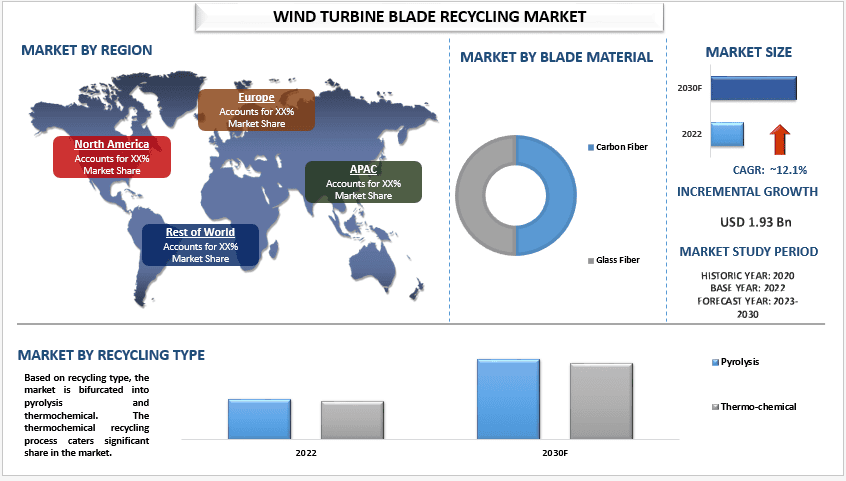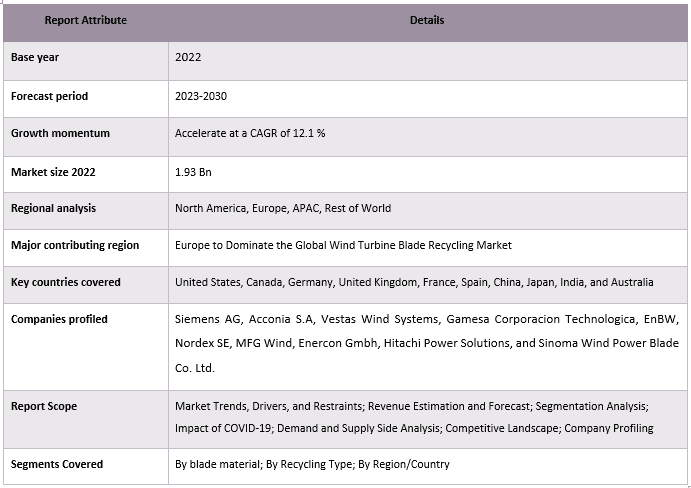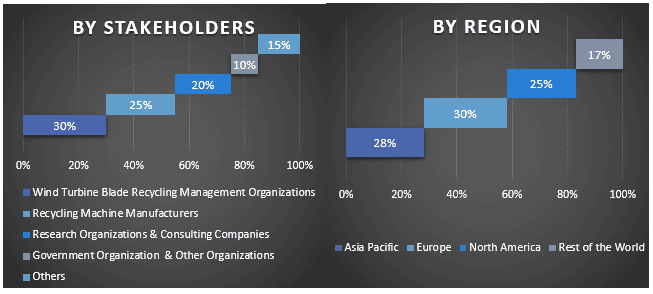
全球风力涡轮机叶片回收市场在2022年估值为19.3亿美元,预计在预测期(2023-2030年)内将以12.1%的复合年增长率增长。风力涡轮机叶片回收市场是指处理风力涡轮机叶片回收和处置的行业。随着风能作为可再生能源变得越来越受欢迎,退役或损坏的风力涡轮机叶片的数量正在增加。对这些叶片的适当回收对于最大限度地减少其对环境的影响至关重要。由于复杂的组成和尺寸等因素,风力涡轮机叶片无法轻易地在传统的废物管理系统中进行处理。这导致了风力涡轮机叶片回收市场的出现,旨在解决回收这种大型结构的挑战。
由于风力发电的增长,近年来对回收风力涡轮机叶片的需求有所增加。随着技术的进步,现有的风力涡轮机将被退役或更换,这将产生大量的废物。2019年,全球海上风电装机容量达到29.1吉瓦。到2050年,预计将有85吉瓦的风电场容量退役,产生325,000个叶片.
西门子公司、Acciona S.A、维斯塔斯风力系统公司、歌美飒技术公司、EnBW、Nordex SE、MFG Wind、Enercon Gmbh、日立电力解决方案公司和中材风电叶片有限公司是市场中的一些主要参与者。这些参与者已经进行了一些并购以及合作,以帮助客户获得高科技和创新产品/技术。
报告中呈现的见解
“在叶片材料中,玻璃纤维类别在预测期内将见证更高的复合年增长率。”
根据叶片材料,风力涡轮机叶片回收市场被细分为碳纤维和玻璃纤维。预计玻璃纤维部分将在预测年份满足 значительная 需求。由于其相对于碳纤维的较低成本,玻璃纤维一直是风力涡轮机叶片的传统选择。它还提供良好的耐用性,并已广泛建立回收流程。这些因素促成了玻璃纤维叶片拥有更大的市场份额。
“在回收类型中,热解部分在2022年将占据 значительная 市场份额。”
根据回收类型,风力涡轮机叶片回收市场被归类为热解和热化学。热解部分占据该市场的主要份额。热解以其生产有价值的副产品(如碳纤维)的能力而闻名,而热化学工艺有可能产生更高的能量回收率.
“欧洲将在市场中占据 значительная 份额。”
预计欧洲将在风力涡轮机叶片回收市场中占据最高的份额。欧洲已经建立了成熟的回收基础设施和产业。许多欧洲国家在废物管理和材料回收方面已经经验丰富。这种现有的基础设施使得欧洲能够更有效地处理风力涡轮机叶片的回收。因此,欧洲面临着对风力涡轮机叶片回收日益增长的需求。此外,欧盟已经实施了严格的可持续能源生产法规和目标,包括风能。这些法规强调负责任和环保地处理退役风力涡轮机叶片,从而促进风力涡轮机回收计划的增长。
风力涡轮机叶片回收市场报告范围

购买本报告的原因:
- 该研究包括经认证的行业关键专家验证的市场规模和预测分析。
- 该报告快速概览了整个行业的业绩。
- 该报告涵盖了对突出行业同行的深入分析,主要侧重于关键的业务财务、产品组合、扩张策略和最新发展。
- 对行业中普遍存在的驱动因素、限制因素、关键趋势和机遇的详细考察。
- 该研究全面涵盖了不同市场细分市场。
- 对行业进行深层次的区域级分析。
定制选项:
全球风力涡轮机叶片回收市场可根据要求或任何其他细分市场进行进一步定制。此外,UMI 理解您可能有自己的业务需求,因此请随时与我们联系以获得完全符合您要求的报告。
目录
风力涡轮机叶片回收市场分析的研究方法(2023-2030)
分析历史市场、估算当前市场以及预测全球风力涡轮机叶片回收市场的未来市场,是创建和分析风力涡轮机叶片回收在全球主要地区采用的三个主要步骤。进行了详尽的二手研究,以收集历史市场数据并估算当前的市场规模。其次,为了验证这些见解,考虑了许多发现和假设。此外,还与全球风力涡轮机叶片回收市场价值链中的行业专家进行了详尽的主要访谈。在通过主要访谈对市场数据进行假设和验证后,我们采用了自上而下/自下而上的方法来预测完整的市场规模。此后,采用了市场细分和数据三角剖分方法来估算和分析与行业相关的细分市场和子细分市场的市场规模。下面解释了详细的方法:
历史市场规模分析
第1步:深入研究二手资料:
进行了详细的二手研究,以通过公司内部资料(例如)获得风力涡轮机叶片回收市场的历史市场规模年度报告和财务报表、业绩演示、新闻稿等,以及包括在内的外部资源期刊、新闻和文章、政府出版物、竞争对手出版物、行业报告、第三方数据库和其他可靠出版物。
第2步:市场细分:
在获得风力涡轮机叶片回收市场的历史市场规模后,我们进行了详细的二手分析,以收集主要地区不同细分市场和子细分市场的历史市场见解和份额。主要细分市场包括在报告中作为叶片材料和回收类型。进一步进行了国家层面的分析,以评估在该地区测试模型的整体采用情况。
第3步:因素分析:
在获得不同细分市场和子细分市场的历史市场规模后,我们进行了详细的因素分析以估算风力涡轮机叶片回收市场的当前市场规模。此外,我们使用因变量和自变量(例如风力涡轮机叶片回收的叶片材料和回收类型)进行了因素分析。全面分析了供需情况,考虑了全球风力涡轮机叶片回收市场领域的顶级合作关系、并购、业务扩张和产品发布。
当前市场规模估算与预测
当前市场规模确定:根据以上3个步骤的可操作见解,我们得出了当前市场规模、全球风力涡轮机叶片回收市场的关键参与者以及细分市场的市场份额。所有所需的百分比份额拆分和市场细分均使用上述二手方法确定,并通过主要访谈进行了验证。
估算与预测:对于市场估算和预测,为不同因素分配了权重,包括驱动因素和趋势、限制因素以及利益相关者可用的机会。在分析了这些因素后,应用了相关的预测技术,即自上而下/自下而上的方法,以得出2030年全球主要市场不同细分市场和子细分市场的市场预测。用于估算市场规模的研究方法包括:
- 行业的市场规模,以收入(美元)和风力涡轮机叶片回收市场在主要国内市场的采用率表示
- 所有市场细分市场和子细分市场的百分比份额、拆分和细分
- 全球风力涡轮机叶片回收市场主要参与者的产品供应情况。此外,这些参与者为应对快速增长的市场而采取的增长战略。
市场规模和份额验证
初步研究:与主要地区的关键意见领袖(KOL),包括高层管理人员(CXO/副总裁、销售主管、市场营销主管、运营主管、区域主管、国家主管等)进行了深入访谈。然后总结初步研究结果,并进行统计分析以证明既定假设。初步研究的输入与二手发现相结合,从而将信息转化为可操作的见解。
不同地区主要参与者的划分

市场工程
采用数据三角测量技术来完成整体市场估算,并得出全球叶片材料和回收类型市场每个细分市场和子细分市场的精确统计数据。在研究了全球风力涡轮机叶片回收市场中叶片材料和回收类型的各个参数和趋势之后,将数据拆分为几个细分市场和子细分市场。
全球风力涡轮机叶片回收市场研究的主要目标
研究确定了全球风力涡轮机叶片回收市场的当前和未来市场趋势。投资者可以获得战略见解,以便根据研究中进行的定性和定量分析来决定投资。当前和未来的市场趋势决定了市场在区域层面的整体吸引力,为行业参与者提供了一个平台,以利用未开发的市场,从而获得先发优势。研究的其他定量目标包括:
- 按价值(美元)分析风力涡轮机叶片回收市场的当前和预测市场规模。此外,分析不同细分市场和子细分市场的当前和预测市场规模。
- 研究中的细分市场包括叶片材料和回收类型领域。
- 定义和分析风力涡轮机叶片回收的监管框架
- 分析涉及各种中介机构的价值链,以及分析行业的客户和竞争对手行为。
- 分析主要地区风力涡轮机叶片回收市场的当前和预测市场规模。
- 报告中研究的地区主要国家包括亚太地区、欧洲、北美和世界其他地区。
- 风力涡轮机叶片回收市场的公司概况以及市场参与者为在快速增长的市场中保持生存而采取的增长战略。
- 对行业进行深入的区域级分析
常见问题 常见问题
问题1:全球风力涡轮机叶片回收市场的当前市场规模和增长潜力是什么?
问题2:全球风力涡轮机叶片回收市场增长的驱动因素是什么?
问题3:按类型划分,哪个细分市场在全球风力涡轮机叶片回收市场中占据最大份额?
问题4:全球风力涡轮机叶片回收市场的新兴技术和趋势是什么?
问题5:哪个地区将主导全球风力涡轮机叶片回收市场?
问题6:哪些是运营在全球风力涡轮机叶片回收市场中的主要参与者?
相关 报告
购买此商品的客户也购买了










